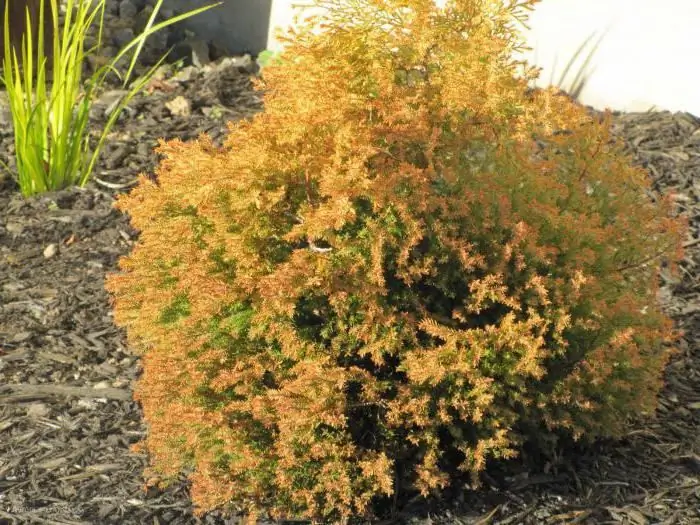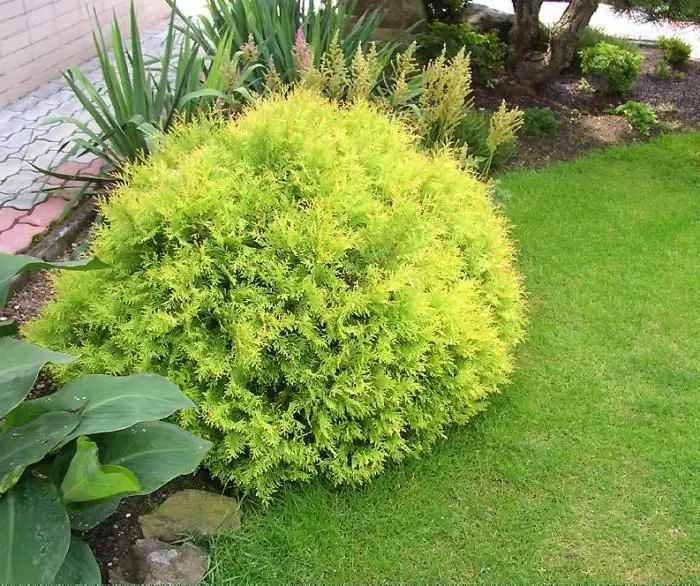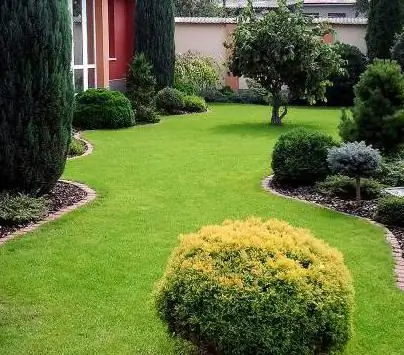The thuja plant belongs to the Cypress family and has more than 120 varieties. Among them there are both small shrubs and trees of a rather impressive size. The dwarf forms include the Rheingold variety - a thuja no more than 3 meters high, belonging to the western subspecies.
Description
The natural range of this plant is the countries of Southeast Asia (Japan, Korea, China). But recently, thuja has become widespread in Europe, having moved from there to the New World. Thanks to its unpretentiousness to environmental conditions and the ability to be cultivated in the open field, this plant, which has fallen in love with people, has become actively used in urban gardening.

Thuja western Rheingold is a shrub up to 3 m in height with a spherical crown at a young age and an oval-ovate over the years. The growth rate is approximately 10 cm per year. During the season, the needles change color from bright golden (spring) to bronze-brown (autumn and winter). It is the unusual color of the plant that often determines the fact that designers andamateur gardeners prefer this variety to other subspecies of thuja western.
Planting and care
Reingold - thuja is unpretentious, can grow both in sunny and shaded places. However, in the latter case, the color of its needles will not be so bright and expressive. Landing in the ground is carried out on a small embankment so that the root system is at a height of about 10 cm above the ground. This helps to avoid strong subsidence of the soil under the weight of the plant's own weight. The components of the soil mixture used for growing thuja are turf, peat and sand in a ratio of 2:1:1. Despite the fact that the plant is not too demanding on soil fertility, with the help of mineral and organic fertilizers, its better development and growth can be achieved.

Reingold is a thuja that prefers places protected from the wind. The plant also does not tolerate excess moisture. To avoid it, it is necessary to create a drainage, which is used as a layer of crushed stone 10-20 cm thick. At the same time, you should not overdry the soil either. Up to two buckets per week per plant, depending on the weather and humidity of the season, will be sufficient for watering. Periodically after weeding, surface loosening should be carried out (no more than 20 cm in depth). Before the winter period, it is necessary to cut the thuja. Otherwise, the plant may not withstand the snow load. Pruning dry branches in the spring is also necessary.
Application in landscape design
Thuya Reingold, described above,looks equally good both in single plantings and when creating compositions from several plants. In the latter case, shrubs can be arranged as hedges or placed in groups. Thus, they will effectively decorate gardens, terraces, small rocky ponds, giving them the necessary color accent in contrast with other coniferous and deciduous plants.

Reingold - thuja, which not only gives a unique look to the garden, ennobling it, but is also an excellent air purifier. The spicy aroma that fills the surrounding space is well known to lovers of this plant.






